 |
Zain al-'Abidin (1420-70) |
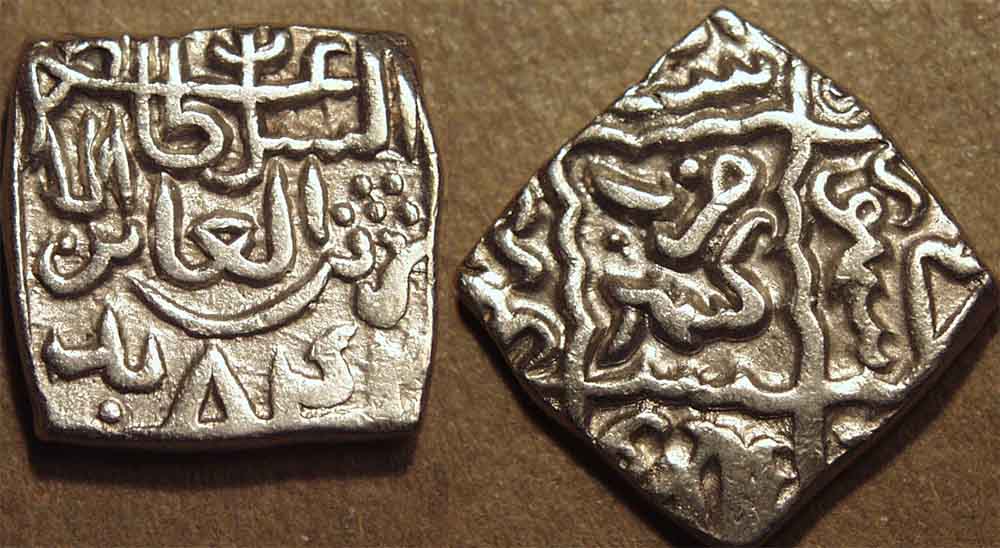
|
Zain al-'Abidin (1420-70) Silver sasnu
Weight: 6.17 gm., Dimensions: 16 x 16 mm.
Legend: al-sultan al-a'zam zain al-'abidin, and frozen AH date 842 /
Within central ornamental diamond: zarb Kashmir, date spelled out in margins
Ref: Rajgor 2797, Goron-Goenka K9 |
 |
Zain al-'Abidin is the first known Kashmir sultan to have issued silver coins, and the first sultan whose name is listed on known coins.
(Some anonymous copper coins have been attributed to Sikandar Shah I, who ruled 1393-1413.) This coin carries a 7-pellet "flower" (or sun?) under the word sultan on the
obverse.
|
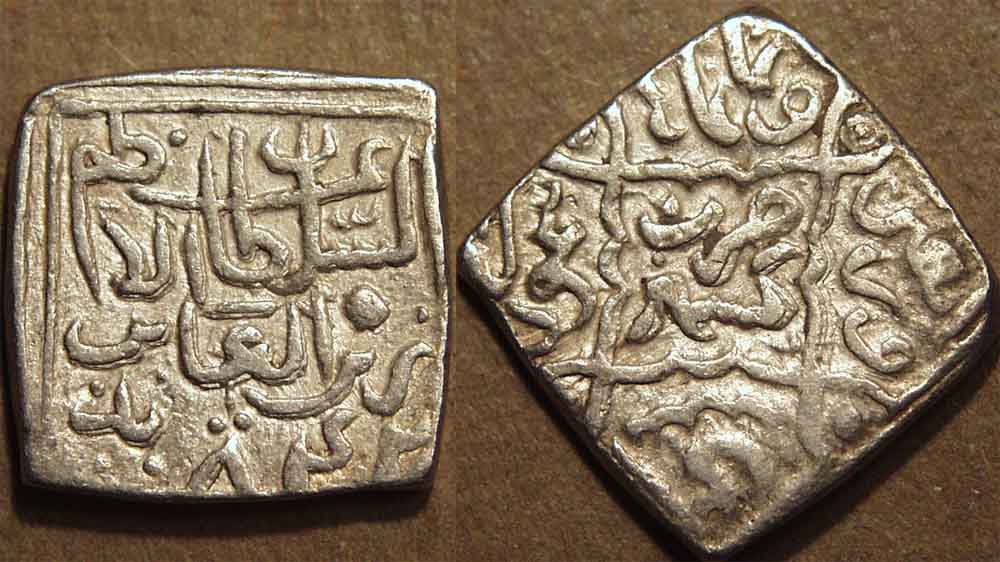
|
Zain al-'Abidin (1420-70) Silver sasnu
Weight: 6.03 gm., Dimensions: 17 x 17 mm.
Legend: al-sultan al-a'zam zain al-'abidin, and frozen AH date 842 /
Within central ornamental diamond: zarb Kashmir, date spelled out in margins
Ref: Rajgor 2797 var, Goron-Goenka K9 var |
 |
This coin does not carry the 7-pellet flower under the word sultan on the obverse that is seen on GG K9 or Rajgor 2797. Instead, it
shows a large single pellet, perhaps representing the sun.
|
 |
 |
 |
Hasan Shah (1472-84) |
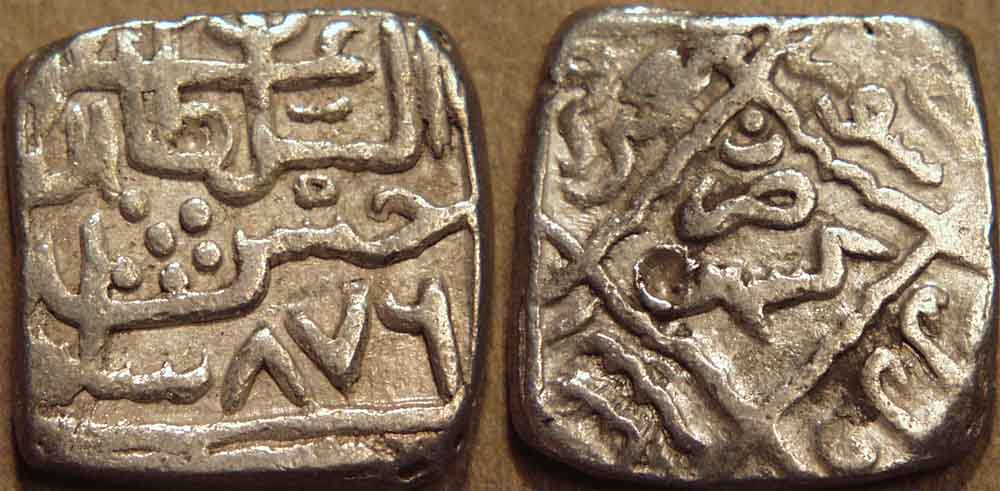
|
Hasan Shah (1472-84) Silver sasnu
Weight: 6.11 gm., Dimensions: 17 x 17 mm.
Legend: al-sultan al-a'zam hasan shah, and AH date 876 (= 1471-72 CE) /
Within central ornamental diamond: zarb Kashmir, date spelled out in margins
Ref: Rajgor 2823, Goron-Goenka K31 |
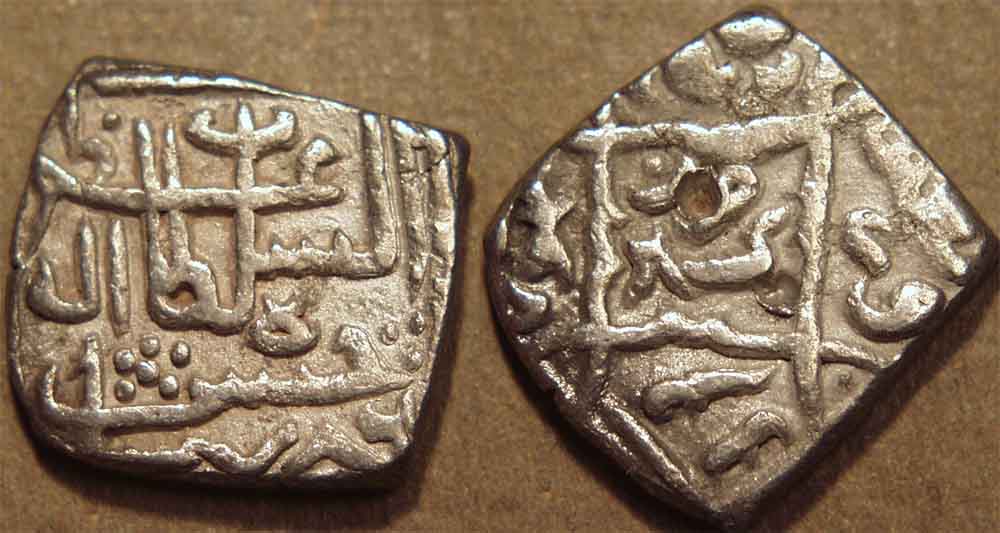
|
Hasan Shah (1472-84) Silver sasnu, with date error
Weight: 6.10 gm., Dimensions: 17 x 16 mm.
Legend: al-sultan al-a'zam hasan shah, and AH date 786 (error for 876) /
Within central ornamental diamond: zarb Kashmir, date spelled out in margins
Ref: Rajgor 2823 var, Goron-Goenka K31 var |
 |
Muhammad Shah (1484-1537, in 5 reigns) |
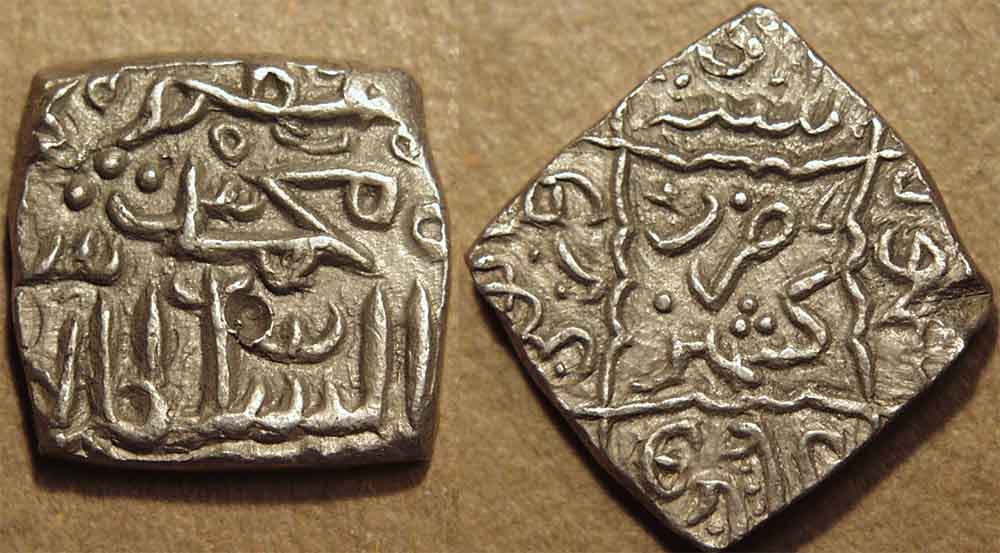
|
Muhammad Shah (1484-1537) Silver sasnu
Weight: 6.18 gm., Dimensions: 16 x 16 mm.
Legend: al-sultan al-a'zam muhammad shah /
Within central ornamental diamond: zarb Kashmir, date spelled out in margins
c. AH 923-43 (= 1517-37 CE), during the Shah's fourth or fifth reigns
Ref: Rajgor 2832, Goron-Goenka K42 |

|
Muhammad Shah (1484-1537) Silver sasnu
Weight: 6.22 gm., Dimensions: 16 x 16 mm.
Legend: al-sultan al-a'zam muhammad shah /
Within central ornamental diamond: zarb Kashmir, date spelled out in margins
c. AH 923-43 (= 1517-37 CE), during the Shah's fourth or fifth reigns
Ref: Rajgor ---, Goron-Goenka K43 |
 |
This variety has no date (in numerals) on the obverse.
|
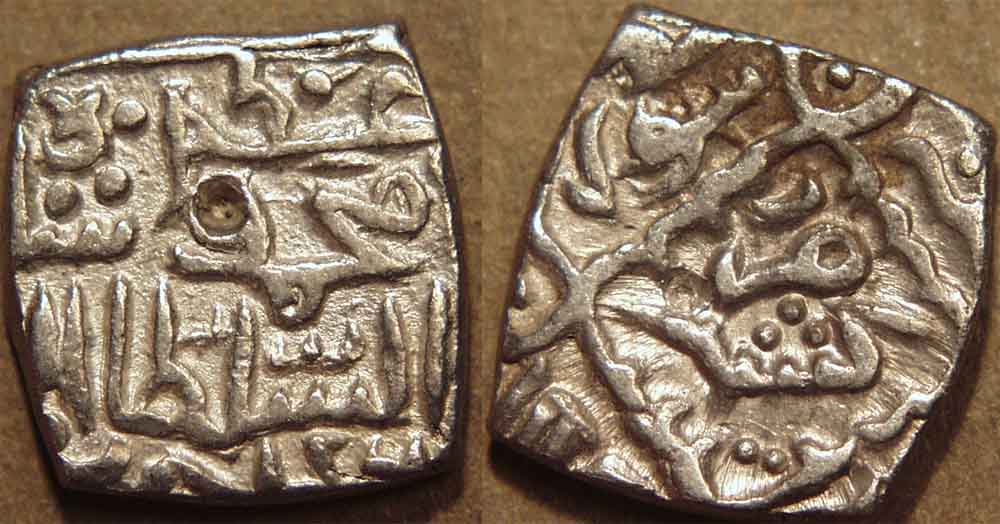
|
Muhammad Shah (1484-1537) Silver sasnu
Weight: 6.18 gm., Dimensions: 16 x 16 mm.
Legend: al-sultan al-a'zam muhammad shah , with fixed date 842 below/
Within central ornamental diamond: zarb Kashmir, date spelled out in margins
c. AH 923-43 (= 1517-37 CE), during the Shah's fourth or fifth reigns
Ref: Rajgor ---, Goron-Goenka K44 |
 |
This coin differs from the normal Muhammad Shah coins in that the word azam at the top of the obverse legend is located
above the word muhammad only, whereas in the normal coins (K42) the word azam stretches all the way across the flan above the words muhammad shah.
|
 |
 |
 |
Fath Shah (1487-1517, in 3 reigns) |
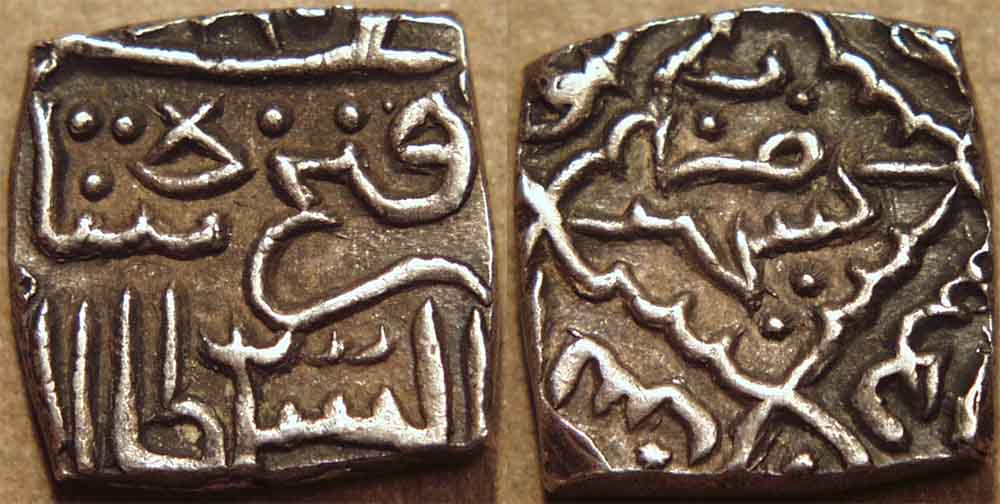
|
Fath Shah (1487-1517) Silver sasnu
Weight: 6.23 gm., Dimensions: 15 x 15 mm.
Legend: al-sultan al-a'zam fath shah /
Within central ornamental diamond: zarb Kashmir, frozen date 842 spelled out in margins
probably issued during the Shah's second or third reigns
Ref: Rajgor 2844, Goron-Goenka K57 |
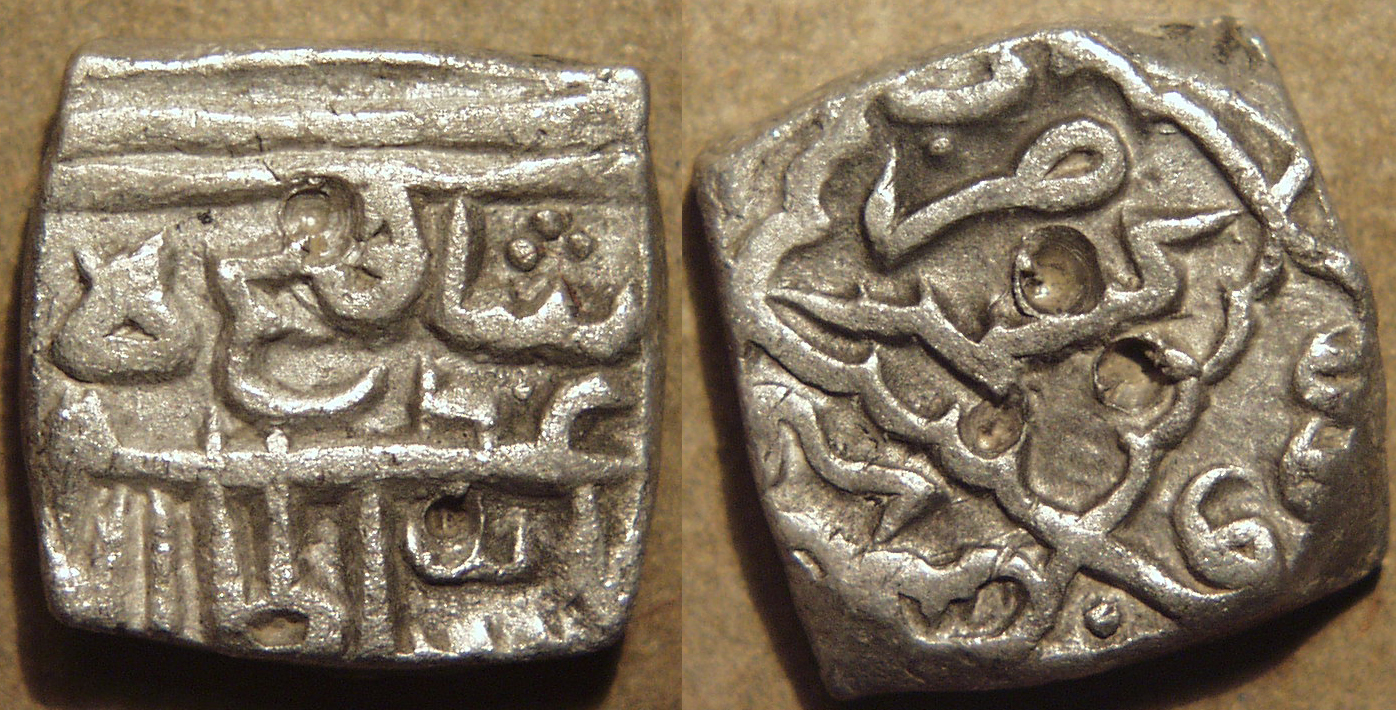
|
Fath Shah (1487-1517) Silver sasnu
Weight: 6.08 gm., Dimensions: 15 x 15 mm.
Legend: shah fath al-sultan al-a'zam /
Within central ornamental diamond: zarb Kashmir, frozen date 842 spelled out in margins
probably issued during the Shah's second or third reigns
Ref: Rajgor ---, Goron-Goenka K57A |
 |
A very rare variety which differs from the usual coins of Fath Shah in placing his name at the top and writing it as shah fath,
with the letter he of shah actually placed after fath. Rajgor did not know of this type and Goron & Goenka classify it as RR.
|
 |
 |
 |
Sikandar Shah (1517) |
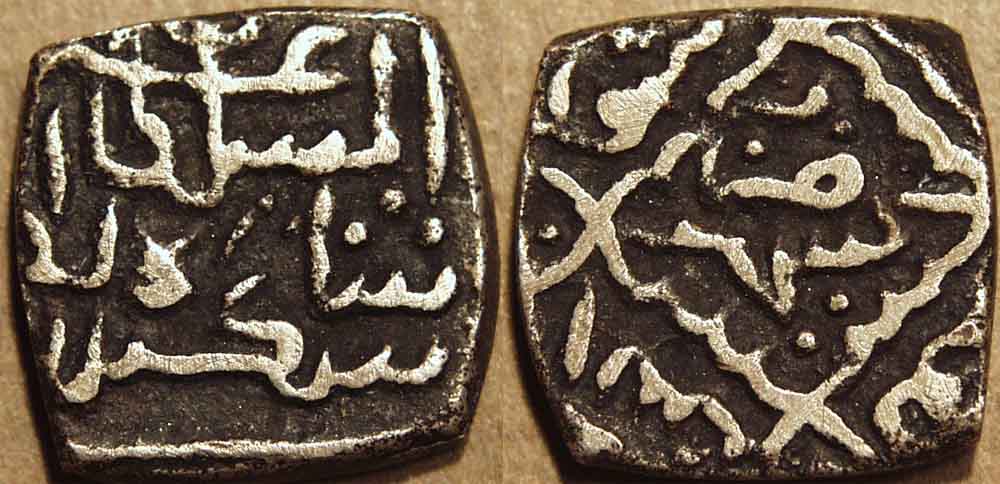
|
Sikandar Shah (1517) Silver sasnu
Weight: 5.04 gm., Dimensions: 16 x 16 mm.
Legend: al-sultan al-a'zam sikandar shah /
Within central ornamental diamond: zarb Kashmir, frozen date 842 spelled out in margins
Ref: Rajgor 2775, Goron-Goenka K71 (same dies) |
 |
According to Goron & Goenka, this type used to be attributed to Sikandar Shah of Kashmir, who ruled 1493-1513, but die analysis
shows that it was struck later in the 1510's. So the prevailing theory is that it was struck in 1517 by Muhammad Shah in the name of Sikandar Lodi, in gratitude for his aid in
helping Muhammad Shah regain his throne. Another possibility is that it is an issue of Fath Shah's son Sikandar, who was briefly a claimant to the throne. I confess I like this
theory better.
|
 |
 |
 |
Ibrahim Shah I (1528-29) |
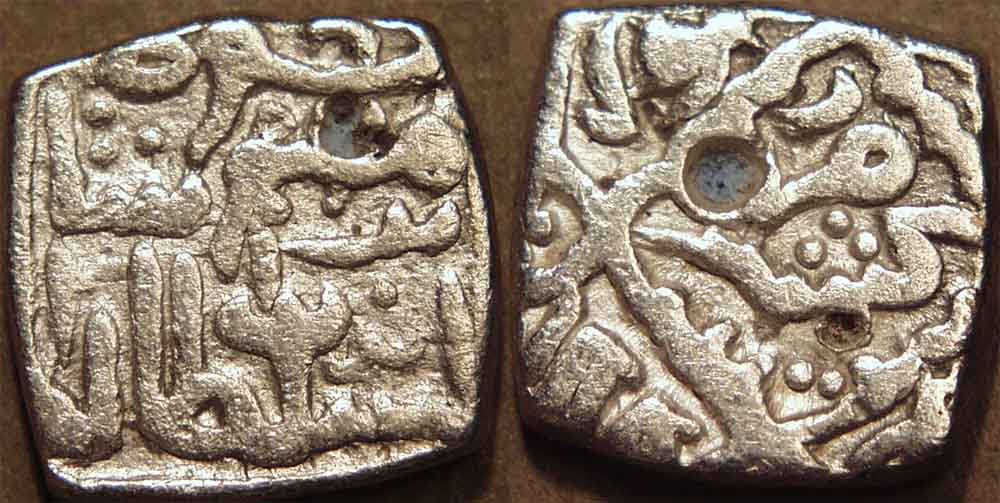
|
Ibrahim Shah I (1528-29) Silver sasnu
Weight: 6.00 gm., Dimensions: 16 x 16 mm.
Legend: al-sultan al-a'zam ibrahim shah, with bra on third line, below i-him /
Within central ornamental diamond: zarb Kashmir, frozen date 842 spelled out in margins
probably issued during the Shah's second or third reigns
Ref: Rajgor Rajgor 2861, Goron-Goenka K76 |
 |
This could be an issue of Ibrahim Shah II some 10 years later.
|
 |
 |
 |
Haidar Dughlat (1533) as vassal of Sa'id Khan of Kashgar |

|
Haidar Dughlat (1533) Silver sasnu in name of Sa'id Khan of Kashgar
Weight: 5.77 gm., Dimensions: 15 x 16 mm.
Legend: al-sultan al-a'zam mir sa'id ghan /
Within central ornamental diamond: zarb Kashmir, frozen date 842 spelled out in margins
Ref: Rajgor 2888 var , Goron-Goenka K86 |
 |
Haidar Dughlat of Kashgar invaded Kashmir in 1533 and issued coins in the name of his king, Sa'id Khan. This incursion was
short-lived, however, and, some years later, Haidar Dughlat was to return apparently as a vassal of the Mughal emperor Humayun. The Sa'id Khan coins were issued over a
very short period of perhaps less than a year.
|
 |
 |
 |
Shams al-Din Shah II (1537-38) |
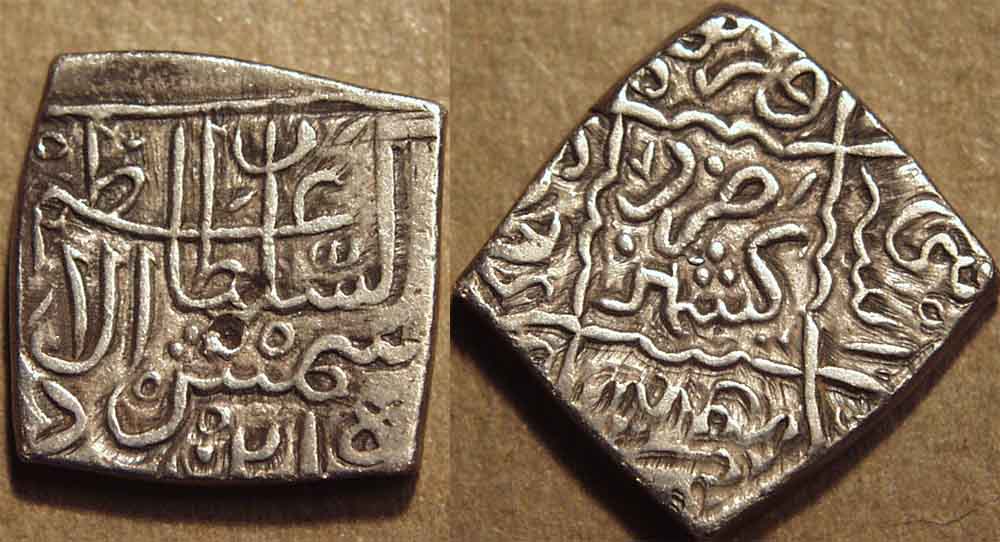
|
Shams al-Din Shah II (1537-38) Silver sasnu
Weight: 6.16 gm., Dimensions: 16 x 16 mm.
Legend: al-sultan al-a'zam shams al-din shah /
Within central ornamental diamond: zarb Kashmir, frozen date 842 spelled out in margins
Ref: Rajgor ---, Goron-Goenka K92 (same dies) |
 |
The fine style of this coin is unmatched in the entire Kashmir Sultanate series.
|
 |
 |
 |
Isma'il Shah I (1538-40) |

|
Isma'il Shah I (1538-40) Silver sasnu
Weight: 6.10 gm., Dimensions: 15 x 16 mm.
Legend: al-sultan al-a'zam isma'il shah /
Within central ornamental diamond: zarb Kashmir, frozen date 842 spelled out in margins
Ref: Rajgor 2866, Goron-Goenka K95 |
 |
Nazuk (Nadir) Shah (1540-1546) |
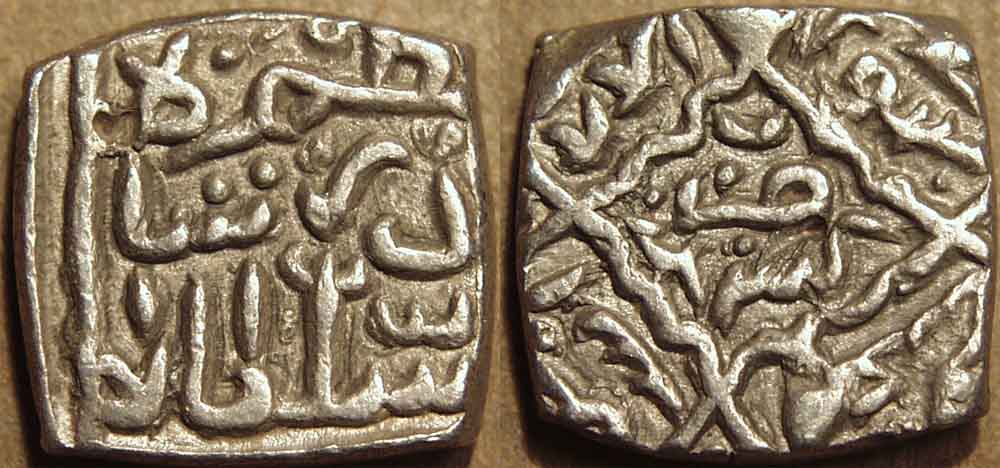
|
Nazuk (Nadir) Shah (1540-1546) Silver sasnu
Weight: 6.22 gm., Dimensions: 15 x 15 mm.
Legend: al-sultan al-a'zam nadir shah /
Within central ornamental diamond: zarb Kashmir, blundered date 842 spelled out in margins
Ref: Rajgor 2848, Goron-Goenka K100 |
 |
Haidar Dughlat (1546-1550) as vassal of Humayun |
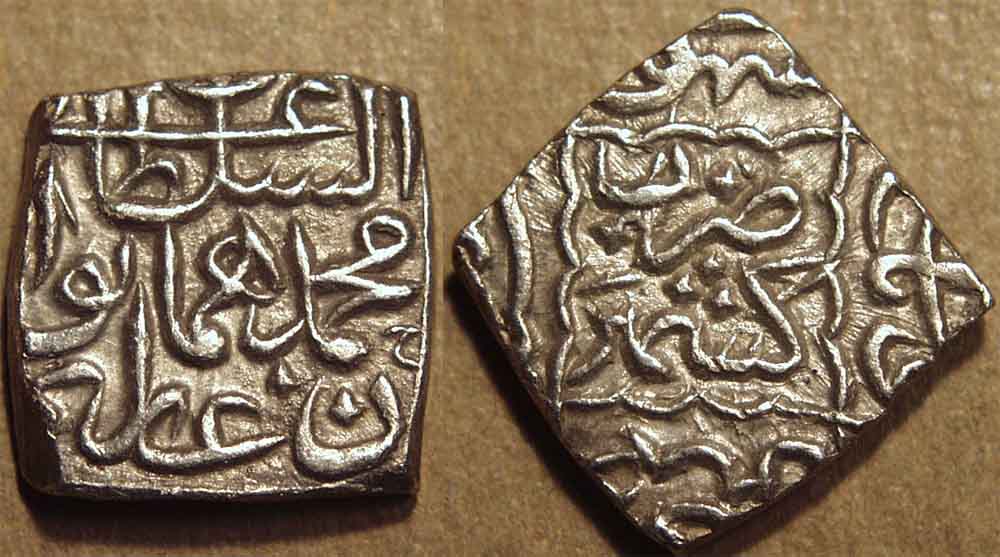
|
Haidar Dughlat (1546-50) Silver sasnu in name of Humayun
Weight: 6.15 gm., Dimensions: 15 x 15 mm.
Legend: al-sultan al-a'zam muhammad humayun ghazi /
Within central ornamental diamond: zarb Kashmir, spelled out in margins:
AH date 953 (= 1546-47 CE)
Ref: Rajgor 2853, Goron-Goenka K104 |
 |
Haidar Dughlat ruled Kashmir again from 1546 to 1550, but issued coins only in the name of the Mughal emperor Humayun.
|
 |
 |
 |
Husain Shah (1562-70) |
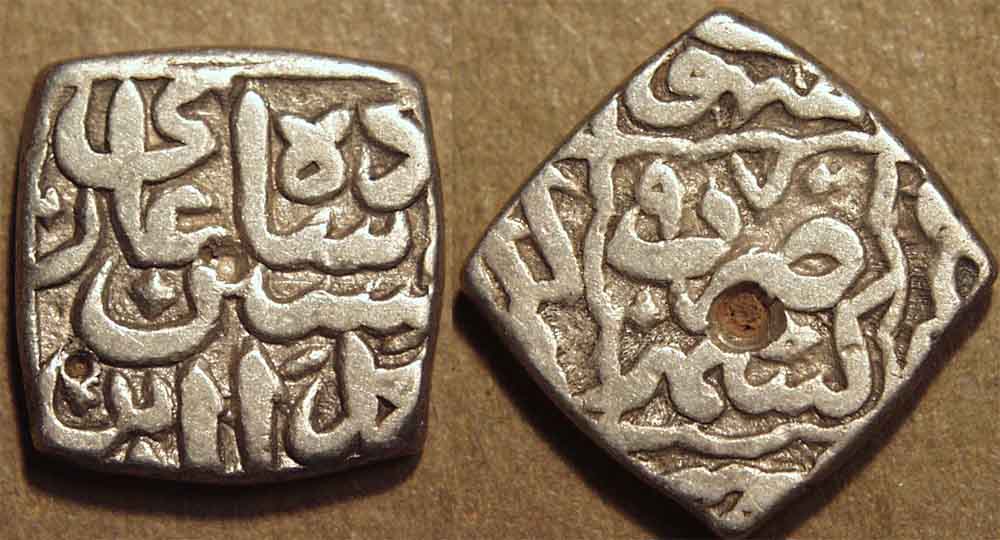
|
Husain Shah (1562-70) Silver sasnu
Weight: 6.03 gm., Dimensions: 15 x 16 mm.
Legend: nasir al-din muhammad husain badshah ghazi /
Within central ornamental diamond: zarb Kashmir, and date 970 (= 1562-63 CE),
date also spelled out in margins
Ref: Rajgor ---, Goron-Goenka K121 var |
 |
This coin has a very attractive, bold style which is most unusual in the Kashmir Sultanate series. This particular legend arrangement
was not included in Rajgor's catalogue, and this date (970) is not listed for this type by Goron & Goenka.
|
 |
 |
 |
Muhammad Yusuf Shah (1579-86) |

|
Muhammad Yusuf Shah (1579-86) Silver sasnu
Weight: 6.13 gm., Dimensions: 17 x 16 mm.
Legend: nasir al-din muhammad yusuf badshah ghazi /
Within central ornamental diamond: zarb Kashmir, and date 987 (= 1579-80 CE),
date also spelled out in margins
Ref: Rajgor 2885, Goron-Goenka K135 |
 |
The Kashmir Sultanate came to an end around 1586 when it was absorbed into the Mughal empire.
|